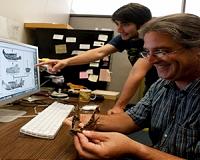| . |  |
. |
Cambridge MA (SPX) Aug 31, 2010 Scientists at Harvard University have sketched a new map of the "evolutionary labyrinth" species must traverse to reach eusociality, the rare but spectacularly successful social structure where individuals cooperate to raise offspring. Mathematical biologists Martin A. Nowak and Corina E. Tarnita and evolutionary biologist Edward O. Wilson present their work this week in the journal Nature. Their modeling shows that the straightforward natural selection theory alone can explain the evolution of eusocial behavior, without the need for kin selection theory. "The empirical evidence gathered in our paper demonstrates that eusociality is exceedingly rare because species must navigate a lengthy evolutionary labyrinth to reach this state," says Wilson, the Pellegrino University Professor, Emeritus, at Harvard. "We hope our new theory for the evolution of eusociality will open up sociobiology to new avenues of research by liberating the study of social evolution from mandatory adherence to kin selection theory. After four decades ruling the roost, it is time to recognize this theory's very limited prowess." Eusocial organisms, such as ants, wasps, and bees, form hierarchical social systems with reproductive queens and sterile workers, meaning many individuals take the evolutionarily counterintuitive step of sacrificing their own reproduction to care for the offspring of others. For four decades kin selection theory, based on the concept of inclusive fitness, has been the major theoretical attempt to explain the evolution of such behavior. "In some situations, inclusive fitness theory, which tries to calculate fitness effects conferred on relatives, is a suitable alternative to standard population genetics," says Nowak, professor of mathematics and of biology at Harvard and director of the university's Program for Evolutionary Dynamics. "But it is not applicable in general. Our analysis shows that inclusive fitness theory rests on fragile assumptions, which rarely hold in nature. Contrary to many previous claims, we prove that inclusive fitness theory is not an extended theory of evolution and is not needed to explain eusociality. Standard natural selection theory represents a simpler and superior approach, and provides an exact framework for interpreting empirical observations." Eusociality is rare, but important in evolutionary biology because the few species that adhere to it, including social insects and, to an extent, humans rank among the planet's most dominant. The biomass of ants alone composes more than half that of all insects, exceeding that of all terrestrial nonhuman vertebrates combined. Humans, who are more loosely eusocial, dominate land vertebrates. "Eusociality has arisen independently some 10 to 20 times in the course of evolution," says Tarnita, a junior fellow in Harvard's Society of Fellows. "Our model shows that it is difficult to get eusociality in the first place, but that it is very stable once it is established. A colony behaves like a 'superorganism,' reproducing the genome of the queen and the sperm she has stored." Nowak, Tarnita, and Wilson's proposal on eusocial evolution sketches out three distinct steps species can take to sidestep eusociality's evolutionary cost: First, species must form groups within a population, such as when nests or food attract individuals to discrete locations some distance apart, when parents and offspring remain together, or when migrating flocks follow leaders. Second, species must accumulate traits, arising through ordinary natural selection, that favor the switch to eusociality. For instance, Ceratina and Lasioglossum bees, which appear perched on the cusp of eusociality, cooperate in foraging, tunneling, and guarding resources. Another such pre-adaptation is progressive provisioning, in which a female builds a nest, lays an egg in it, and then feeds or guards larvae until they mature. Most importantly, the candidate species must build a defensible nest. Finally, individuals must develop genes supporting eusociality, whether by mutation or recombination. Crossing the threshold to eusociality essentially requires that a female and her offspring not disperse to start new, individual nests, but rather remain at the old nest. While eusocial genes have yet to be identified, at least two eusocial ant species are known to have genes that quell the urge to roam from the nest. If these steps are followed and a species becomes eusocial, the evolutionary costs of individuals foregoing reproduction are compensated by the greatly reduced mortality of the queen and her larvae, which are protected by the colony. In some ant species, a queen that might live for only a few months if alone can live for 25 years or more as part of a colony, producing millions of offspring in the process.
Share This Article With Planet Earth
Related Links Harvard University Darwin Today At TerraDaily.com
 Carnivore Species Shrank During Global Warming Event
Carnivore Species Shrank During Global Warming EventGainesville FL (SPX) Aug 31, 2010 A new University of Florida study indicates extinct carnivorous mammals shrank in size during a global warming event that occurred 55 million years ago. The study, scheduled to appear in the December print edition of the Journal of Mammalian Evolution and now available online, describes a new species that evolved to half the size of its ancestors during this period of global warming. ... read more |
|
| The content herein, unless otherwise known to be public domain, are Copyright 1995-2010 - SpaceDaily. AFP and UPI Wire Stories are copyright Agence France-Presse and United Press International. ESA Portal Reports are copyright European Space Agency. All NASA sourced material is public domain. Additional copyrights may apply in whole or part to other bona fide parties. Advertising does not imply endorsement,agreement or approval of any opinions, statements or information provided by SpaceDaily on any Web page published or hosted by SpaceDaily. Privacy Statement |